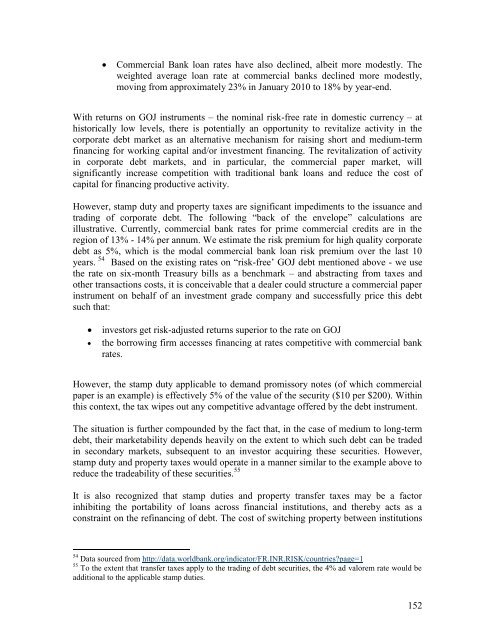PIOJ Growth-Inducement Strategy - Planning Institute of Jamaica
PIOJ Growth-Inducement Strategy - Planning Institute of Jamaica
PIOJ Growth-Inducement Strategy - Planning Institute of Jamaica
You also want an ePaper? Increase the reach of your titles
YUMPU automatically turns print PDFs into web optimized ePapers that Google loves.
Commercial Bank loan rates have also declined, albeit more modestly. The<br />
weighted average loan rate at commercial banks declined more modestly,<br />
moving from approximately 23% in January 2010 to 18% by year-end.<br />
With returns on GOJ instruments – the nominal risk-free rate in domestic currency – at<br />
historically low levels, there is potentially an opportunity to revitalize activity in the<br />
corporate debt market as an alternative mechanism for raising short and medium-term<br />
financing for working capital and/or investment financing. The revitalization <strong>of</strong> activity<br />
in corporate debt markets, and in particular, the commercial paper market, will<br />
significantly increase competition with traditional bank loans and reduce the cost <strong>of</strong><br />
capital for financing productive activity.<br />
However, stamp duty and property taxes are significant impediments to the issuance and<br />
trading <strong>of</strong> corporate debt. The following “back <strong>of</strong> the envelope” calculations are<br />
illustrative. Currently, commercial bank rates for prime commercial credits are in the<br />
region <strong>of</strong> 13% - 14% per annum. We estimate the risk premium for high quality corporate<br />
debt as 5%, which is the modal commercial bank loan risk premium over the last 10<br />
years. 54 Based on the existing rates on “risk-free’ GOJ debt mentioned above - we use<br />
the rate on six-month Treasury bills as a benchmark – and abstracting from taxes and<br />
other transactions costs, it is conceivable that a dealer could structure a commercial paper<br />
instrument on behalf <strong>of</strong> an investment grade company and successfully price this debt<br />
such that:<br />
<br />
<br />
investors get risk-adjusted returns superior to the rate on GOJ<br />
the borrowing firm accesses financing at rates competitive with commercial bank<br />
rates.<br />
However, the stamp duty applicable to demand promissory notes (<strong>of</strong> which commercial<br />
paper is an example) is effectively 5% <strong>of</strong> the value <strong>of</strong> the security ($10 per $200). Within<br />
this context, the tax wipes out any competitive advantage <strong>of</strong>fered by the debt instrument.<br />
The situation is further compounded by the fact that, in the case <strong>of</strong> medium to long-term<br />
debt, their marketability depends heavily on the extent to which such debt can be traded<br />
in secondary markets, subsequent to an investor acquiring these securities. However,<br />
stamp duty and property taxes would operate in a manner similar to the example above to<br />
reduce the tradeability <strong>of</strong> these securities. 55<br />
It is also recognized that stamp duties and property transfer taxes may be a factor<br />
inhibiting the portability <strong>of</strong> loans across financial institutions, and thereby acts as a<br />
constraint on the refinancing <strong>of</strong> debt. The cost <strong>of</strong> switching property between institutions<br />
54 Data sourced from http://data.worldbank.org/indicator/FR.INR.RISK/countries?page=1<br />
55 To the extent that transfer taxes apply to the trading <strong>of</strong> debt securities, the 4% ad valorem rate would be<br />
additional to the applicable stamp duties.<br />
152
















